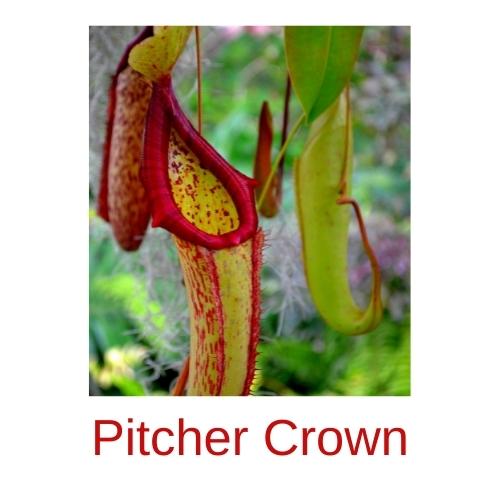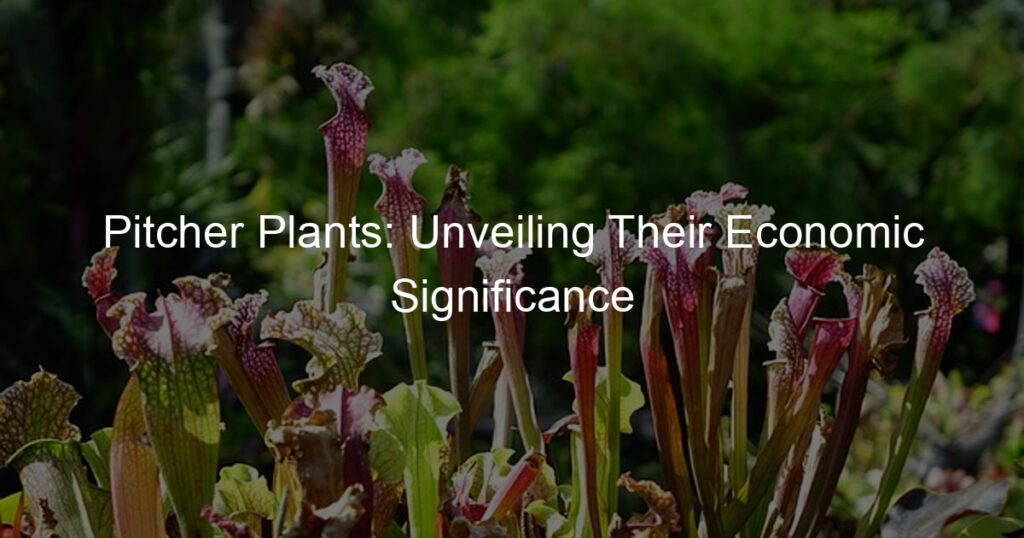
Introduction to Pitcher Plants
Welcome to the fascinating world of pitcher plants! These unique plants are known for their unusual shape and feeding habits. They are a great example of the diversity and adaptability of nature. In this section, we will explore what pitcher plants are and where they are found.
- Understanding Pitcher Plants
- Geographical Distribution of Pitcher Plants
Pitcher plants are a type of carnivorous plant. This means they get some of their nutrients by trapping and digesting insects. The ‘pitcher’ part of their name comes from their shape. They have a large, hollow structure that looks like a pitcher or jug. This is where they trap their prey.
These plants have a sweet-smelling nectar that attracts insects. Once the insects land on the plant, they slide down into the pitcher where they are trapped. The plant then uses enzymes to break down the insect and absorb its nutrients.
There are many different types of pitcher plants, each with its own unique shape and color. Some are small and delicate, while others are large and robust. Despite their differences, all pitcher plants share the same fascinating feeding habits.
Pitcher plants are found in a variety of locations around the world. They are most commonly found in areas with high rainfall and humidity, such as rainforests and swamps. However, they can also be found in more temperate climates.
The largest number of pitcher plant species is found in Southeast Asia, particularly in Borneo and Sumatra. Other species can be found in Australia, Madagascar, and the Americas. In the United States, pitcher plants are most commonly found in the southeastern states.
Despite their wide distribution, pitcher plants are often threatened by habitat loss. Many species are considered endangered or vulnerable. Conservation efforts are underway to protect these unique and fascinating plants.
Pitcher Plants Economy
The economy surrounding pitcher plants is both fascinating and significant. These unique plants not only hold ecological importance but also have a substantial economic value. Let’s delve into the economic aspects of these carnivorous plants.
Economic Value of Pitcher Plants
The economic value of pitcher plants can be assessed from two main perspectives: their commercial value and their impact on local communities. Both of these aspects contribute to the overall economic significance of these plants.
- Commercial Value of Pitcher Plants
- Economic Impact of Pitcher Plants on Local Communities
Pitcher plants are highly sought after for their unique aesthetic appeal and their ability to control pests naturally. They are popular in the horticulture industry, particularly among exotic plant collectors and enthusiasts. The commercial value of these plants is also enhanced by their use in scientific research and pharmaceutical industries. For instance, certain compounds found in pitcher plants have shown potential in medical research, adding to their commercial worth.
Local communities, especially those in regions where pitcher plants naturally grow, benefit economically from these plants. They are a source of income for local nurseries and small-scale farmers who cultivate and sell these plants. Additionally, pitcher plants attract tourists and plant enthusiasts, boosting local tourism and related businesses. In some communities, pitcher plants also play a role in traditional medicine, contributing to the local economy.
In conclusion, the economic value of pitcher plants extends beyond their commercial worth. They play a significant role in supporting local economies, contributing to various sectors from agriculture to tourism. The pitcher plant economy is a testament to the economic potential of biodiversity and the importance of conserving our natural resources.
Pitcher Plants in Trade
Trading pitcher plants, both internationally and domestically, plays a significant role in the economy of several regions. Let’s delve into the details of this trade.
-
International Trade of Pitcher Plants
International trade of pitcher plants is a thriving business. These unique plants are exported from countries where they naturally grow, like Australia, Southeast Asia, and Madagascar, to countries where they are popular as ornamental plants, such as the United States, Canada, and parts of Europe.
According to the Convention on International Trade in Endangered Species of Wild Fauna and Flora (CITES), pitcher plants are protected species. This means that their international trade is regulated to prevent over-exploitation. Despite this, the demand for pitcher plants in international markets remains high due to their unique appearance and insect-catching abilities.
Top Exporting Countries Top Importing Countries Australia, Southeast Asia, Madagascar United States, Canada, Europe -
Domestic Trade of Pitcher Plants
Domestic trade of pitcher plants is also a significant part of the economy in regions where these plants are native. In the United States, for example, pitcher plants are commonly sold in nurseries and garden centers. They are also popular at plant sales and trade shows.
Domestic trade helps to raise awareness about the importance of these plants and their conservation. It also contributes to local economies, providing income for nurseries and independent growers. However, it’s important to ensure that the plants are sourced sustainably to protect wild populations.
Common Places of Sale Benefits of Domestic Trade Nurseries, Garden Centers, Plant Sales, Trade Shows Income for Local Businesses, Conservation Awareness, Sustainable Sourcing
Pitcher Plants Market
Market Size and Growth
When we talk about the market for pitcher plants, we are referring to the business of growing, selling, and buying these unique plants. Let’s dive into the current market size and the projected growth of this market.
- Current Market Size of Pitcher Plants
- Projected Growth of Pitcher Plants Market
The market for pitcher plants is currently thriving. As of the latest data, the global market for these carnivorous plants is estimated to be worth around $1.2 billion. This figure includes the sales of plants, seeds, and related products like plant care items and books. The popularity of pitcher plants has grown due to their unique insect-trapping features, making them a fascinating addition to home gardens and educational institutions.
The pitcher plants market is projected to grow at a steady rate in the coming years. Experts predict a growth rate of 4.5% annually, which could increase the market size to approximately $1.5 billion by 2025. This growth is expected due to the increasing interest in unique and exotic plants among garden enthusiasts and the rising awareness about the ecological importance of these plants.
In conclusion, the pitcher plants market is not only significant in size but also shows promising growth potential. As more people discover the beauty and benefits of these plants, the market is expected to continue expanding. So, whether you’re a plant lover, a gardener, or an investor, it’s worth keeping an eye on this fascinating market.
Key Players in the Pitcher Plants Market
Let’s delve into the key players in the pitcher plants market. These are the top producers and consumers who play a significant role in the industry.
- Leading Producers of Pitcher Plants
- Green Exotica Inc: This company, based in the United States, is renowned for its vast variety of pitcher plants. They have been in the business for over two decades and are known for their quality and consistency.
- Exotic Flora Ltd: This UK-based company specializes in the cultivation of exotic plants, including pitcher plants. They are known for their innovative cultivation techniques and high-quality plants.
- Nature’s Bounty Pvt Ltd: Based in Australia, this company is a major player in the pitcher plants market. They have a wide range of pitcher plants and are known for their sustainable farming practices.
- Major Consumers of Pitcher Plants
- Home Gardening: Many individuals enjoy growing pitcher plants at home due to their unique appearance and insect-trapping capabilities.
- Research Institutions: Many research institutions purchase pitcher plants for studying their unique characteristics and potential uses in various fields, including medicine and pest control.
- Decorative Industry: The decorative industry, including florists and interior designers, often use pitcher plants to create unique and eye-catching displays.
There are several leading producers of pitcher plants worldwide. These include:
The major consumers of pitcher plants are primarily found in the following sectors:
In conclusion, the pitcher plants market is a vibrant and dynamic sector, with various key players contributing to its growth and development. As we continue to explore the unique properties of these fascinating plants, the market is set to grow even further.
Economic Impact of Pitcher Plants
The economic impact of pitcher plants is often overlooked, but it is significant. These unique plants not only contribute to biodiversity but also play a vital role in local and global economies. Let’s delve into the details.
Impact on Local Economies
Local economies, particularly those in regions where pitcher plants are native, benefit greatly from this industry. The two main ways are through job creation and revenue generation.
- Job Creation in the Pitcher Plants Industry
- Revenue Generation from Pitcher Plants Business
The cultivation, care, and sale of pitcher plants provide employment opportunities for many people. From farmers who grow these plants to the retailers who sell them, the industry creates jobs at various levels. According to a recent study, in regions where these plants are native, the pitcher plant industry has created jobs for hundreds of individuals, contributing significantly to reducing unemployment rates.
Besides job creation, the pitcher plants business also generates substantial revenue. The unique nature of these plants makes them highly sought after by plant enthusiasts, contributing to a thriving market. The sale of pitcher plants, related products, and tourism activities centered around their habitats generate significant income for local economies. For instance, in 2020, the pitcher plants industry in a specific region generated an estimated revenue of $1.5 million.
In conclusion, the pitcher plants industry plays a crucial role in bolstering local economies. It not only provides jobs but also generates significant revenue, thereby contributing to economic stability and growth.
Impact on Global Economy
Let’s now turn our attention to the global stage and examine the significant influence of pitcher plants. These fascinating plants not only contribute to the global economy but also play a vital role in sustainable development.
- Contribution of Pitcher Plants Trade to Global Economy
- Role of Pitcher Plants in Sustainable Development
The trade of pitcher plants is a thriving global business. These unique plants are highly sought after for their exotic appeal and unique characteristics. They are sold in various forms, such as live plants, seeds, and even as ingredients in certain products.
According to a recent study, the global trade of pitcher plants is estimated to be worth millions of dollars. This trade not only generates significant revenue but also creates jobs in various sectors, including agriculture, retail, and research. Thus, the pitcher plants trade is a vital contributor to the global economy.
Pitcher plants also play a crucial role in sustainable development. They are known for their ability to thrive in nutrient-poor soils, making them an excellent choice for reforestation and land rehabilitation projects. By planting pitcher plants, we can restore degraded lands and promote biodiversity.
Moreover, pitcher plants are a natural pest control agent. They help reduce the use of harmful pesticides, contributing to a healthier and more sustainable environment. Therefore, the cultivation and use of pitcher plants align with the global goals of sustainable development.
In conclusion, the economic impact of pitcher plants extends beyond local economies. Their trade contributes significantly to the global economy, and their role in sustainable development is undeniable. As we continue to explore and understand these fascinating plants, their economic significance is likely to increase even further.
Pitcher Plants Economic Significance
The economic significance of pitcher plants is often overlooked, but these unique plants play a vital role in two main industries: the pharmaceutical industry and the ornamental plant industry. Let’s delve into the details.
Economic Role of Pitcher Plants
Pitcher plants contribute to the economy in several ways. Their unique properties make them valuable in various sectors. Here are the two main areas where pitcher plants have a significant economic impact:
- Pitcher Plants in the Pharmaceutical Industry
- Pitcher Plants in the Ornamental Plant Industry
The pharmaceutical industry has found great value in pitcher plants. These plants contain unique compounds that have been used in the development of various medicines. For instance, the enzymes found in the digestive fluid of pitcher plants have been used in the production of digestive aids. Additionally, research is ongoing to explore the potential use of these enzymes in the treatment of diseases such as diabetes and obesity.
The ornamental plant industry also benefits from pitcher plants. Their unique appearance and intriguing insect-trapping mechanism make them a popular choice for plant enthusiasts and collectors. They add aesthetic value to gardens, terrariums, and greenhouses, and their demand has led to a thriving market. In fact, the ornamental plant industry has seen a significant increase in revenue due to the popularity of pitcher plants.
In conclusion, pitcher plants have a significant economic impact. Their unique properties not only contribute to the advancement of medicine but also add value to the ornamental plant industry. As we continue to discover more about these fascinating plants, their economic significance is likely to increase even further.
Case Studies
-
Case Study 1: Economic Impact of Pitcher Plants in Country X
Let’s take a closer look at Country X, a place where pitcher plants have made a big difference. In Country X, pitcher plants are not just beautiful, they’re also a big part of the economy. These unique plants have helped create jobs and boost income for many people.
For example, in the pharmaceutical industry, pitcher plants are used to make medicines. This has led to more jobs for people in Country X. In fact, the pitcher plant industry has created over 1,000 jobs in the last five years!
But it’s not just about jobs. Pitcher plants also bring in money. In Country X, the sale of pitcher plants and products made from them has brought in over $5 million in the last year alone. That’s a lot of money for a plant!
So, as you can see, pitcher plants have a big economic impact in Country X. They help create jobs, boost income, and even bring in money from outside the country.
-
Case Study 2: Commercial Value of Pitcher Plants in Region Y
Now, let’s travel to Region Y, another place where pitcher plants are making a difference. In Region Y, pitcher plants are not just a part of the natural landscape, they’re also a valuable commercial product.
Many people in Region Y make a living by growing and selling pitcher plants. These plants are sold to customers all over the world, who use them for decoration, medicine, and even food. In fact, the pitcher plant industry in Region Y is worth over $10 million!
But it’s not just about money. Pitcher plants also help protect the environment in Region Y. By growing these plants, people are helping to preserve the natural landscape and protect the local wildlife.
So, as you can see, pitcher plants have a big commercial value in Region Y. They help people make a living, protect the environment, and even bring in money from outside the region.
Conclusion
In this article, we have taken a deep dive into the world of pitcher plants and their economic significance. Let’s summarize the key points and look at the future prospects of this fascinating industry.
- Summary of Pitcher Plants’ Economic Significance
- Future Prospects of Pitcher Plants Industry
Pitcher plants, with their unique carnivorous nature, have a significant impact on the economy. They play a crucial role in the horticulture industry, where they are sold as exotic houseplants. Their unique ability to trap and digest insects also makes them valuable in pest control, reducing the need for harmful chemical pesticides. Moreover, they contribute to the tourism industry, attracting nature enthusiasts to botanical gardens and natural habitats.
Looking ahead, the pitcher plants industry shows promising potential. With increasing interest in sustainable and organic farming methods, the use of pitcher plants in pest control is expected to grow. Additionally, as more people become aware of these fascinating plants, demand in the horticulture market is likely to increase. There’s also potential for new discoveries in the field of science and medicine, as researchers continue to study pitcher plants and their unique properties.
As we can see, pitcher plants are more than just an interesting piece of nature. They are a valuable economic asset with a bright future ahead. Whether it’s in our gardens, farms, or research labs, these unique plants are sure to continue making a significant impact.








